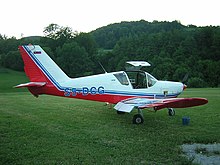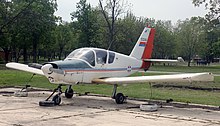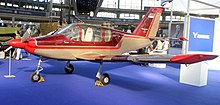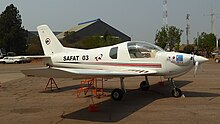| UTVA 75 | |
|---|---|
 Serbian Air Force Utva 75 Serbian Air Force Utva 75 | |
| General information | |
| Type | Military Trainer Aircraft / Civilian Trainer Aircraft |
| National origin | |
| Manufacturer | UTVA |
| Status | Active |
| Primary user | Serbia Air Force |
| History | |
| Introduction date | 1978 |
| First flight | 19 May 1976 |
The UTVA 75 is a light utility aircraft produced by the Serbian aircraft manufacturer UTVA. It was first introduced in the late 1970s and has since been used primarily for training, reconnaissance, and light transport roles. Known for its reliability and versatility, the UTVA 75 has been adopted by several military and civilian operators around the world.







The development of the UTVA 75 began in the early 1970s in response to a need for a new primary trainer aircraft for the Yugoslav Air Force. The first prototype took to the skies in 1976, and following successful testing, the aircraft entered production in 1978. Over the years, the UTVA 75 has seen various upgrades and modifications to enhance its performance and capabilities.
Designed in 1975 to replace the UTVA Aero 3 as the primary basic trainer in the Yugoslav Air Force. It features upward opening gull-wingtype access doors to the two-seat side-by-side cockpit. Another characteristic is a row of air scoops, presumably for cockpit ventilation, in the central front frame of the cockpit. The Utva 75 made its maiden flight in 1976. Between 1978 and 1985, a total of 136 UTVA 75s were produced for the former Yugoslav Air Force. Following the breakup of Yugoslavia, many were passed on to successor states such as Serbia, Slovenia, Croatia, Montenegro.
Development
The UTVA 75 features a fully metallic, semi-monocoque airframe, which provides structural strength and durability. The aircraft is powered by a Lycoming O-360 engine, capable of delivering 210 horsepower. This engine configuration allows the aircraft to achieve a maximum speed of 209 km/h (113 knots) and a service ceiling of 4,178 meters (13,708 feet).
The low-wing design of the UTVA 75 contributes to its stability and maneuverability, which are essential for training and acrobatic maneuvers. The fixed landing gear ensures reliability and reduces maintenance complexity, making it easier for training operations. The cabin is ergonomically designed, featuring adjustable seats and pedals, and provides ample room for both pilots, enhancing comfort during long training sessions.
Design
| This section does not cite any sources. Please help improve this section by adding citations to reliable sources. Unsourced material may be challenged and removed. (August 2023) (Learn how and when to remove this message) |
The UTVA 75 is designed as a low-wing monoplane, emphasizing simplicity and robustness, ideal for training and light utility roles. Here are some detailed aspects of its design and development:
Airframe and Structure
The UTVA 75 features an all-metal construction, primarily using aluminum alloys, which provides a good balance between strength and weight. The low-wing configuration offers excellent visibility for the pilots, which is particularly beneficial during training flights and reconnaissance missions. The aircraft's fixed tricycle landing gear is designed to be sturdy and reliable, capable of operating from both paved runways and rough airstrips.
Powerplant
The aircraft is powered by a single Lycoming IO-360 engine, a four-cylinder, air-cooled, horizontally opposed piston engine. This engine produces 180 horsepower, providing the UTVA 75 with sufficient power for its various roles. The engine is equipped with a two-blade fixed-pitch propeller, which is simple to maintain and operate.
Cockpit and Avionics
The cockpit of the UTVA 75 is designed for two occupants, typically a student and an instructor in a side-by-side seating arrangement. This setup allows for effective communication and instruction during training flights. The aircraft is equipped with dual flight controls, ensuring that both the student and the instructor can operate the aircraft.
The avionics suite in the UTVA 75 is relatively basic, reflecting its primary role as a training aircraft. However, it includes all necessary instruments for VFR (Visual Flight Rules) flight, such as airspeed indicator, altimeter, vertical speed indicator, and a standard set of engine gauges. Some variants may be equipped with additional avionics for specific roles, such as navigation aids for the reconnaissance variant.
Operational history
| This section does not cite any sources. Please help improve this section by adding citations to reliable sources. Unsourced material may be challenged and removed. (August 2023) (Learn how and when to remove this message) |
Performance and Handling
The UTVA 75 is designed to be a stable and forgiving aircraft, making it an excellent platform for primary flight training. Its low-wing configuration and moderate wing loading provide good low-speed handling characteristics and short takeoff and landing capabilities. The aircraft's control surfaces are large and responsive, contributing to its easy handling and maneuverability.
Modifications and Upgrades
Over the years, the UTVA 75 has seen several modifications and upgrades to enhance its performance and adapt it to different roles. These modifications include reinforced landing gear for rough-field operations, additional fuel tanks for extended range, and various mission-specific equipment such as cameras and crop-dusting apparatus.
Operational Use
The UTVA 75 has proven to be a versatile and reliable aircraft, serving in various roles beyond primary training. It has been used for aerial reconnaissance, light transport, liaison duties, and even agricultural applications. Its simple design and robust construction have made it a favorite among operators who require a dependable and easy-to-maintain aircraft.
Overall, the design of the UTVA 75 reflects its intended purpose as a multi-role utility aircraft. Its combination of simplicity, reliability, and versatility has ensured its continued use by both military and civilian operators around the world.
Variants
- UTVA 75A11
- Single-seat agricultural aircraft, largely using the Utva 75 airframe.
- UTVA-75A21
- Two-seater with dual controls and provisions for blind instrument flying.
- UTVA-75A41
- Four-seater with advanced avionics, first flown in 1986.
- SAFAT 03
- A development of the UTVA 75 from the SAFAT Aviation Complex at Khartoum, Sudan, with a modified fuselage and tail fin. To confuse matters the Sudanese Government marked up a standard UTVA 75 as a SAFAT 03. One example known, which was displayed at the Dubai Air Show in 2011.
Operators
- Slovenian Air Force → handed over entirely to aeroclubs for use
- Letalski center Maribor Civil operator (1989-2022)
- Yugoslav Air Force → partially handed over for use to aeroclubs
Specifications (UTVA 75A21)
Data from Jane's All the World's Aircraft 1988-89
General characteristics
- Crew: 2
- Capacity: 210 kg (460 lb) max
- Length: 7.11 m (23 ft 4 in)
- Wingspan: 9.73 m (31 ft 11 in)
- Height: 3.15 m (10 ft 4 in)
- Wing area: 14.63 m (157.5 sq ft)
- Aspect ratio: 6.5
- Empty weight: 685 kg (1,510 lb) equipped
- Max takeoff weight: 960 kg (2,116 lb)
- Fuel capacity: standard:160 L (42 US gal; 35 imp gal): with drop tanks 360 L (95 US gal; 79 imp gal)
- Powerplant: 1 × Lycoming IO-360-B1F 4-cyl. air-cooled horizontally-opposed piston engine, 134 kW (180 hp)
- Propellers: 2-bladed Hartzell HC-C2YK-1BF/F7666A variable-pitch metal propeller
Performance
- Maximum speed: 215 km/h (134 mph, 116 kn)
- Cruise speed: 165 km/h (103 mph, 89 kn)
- Stall speed: 95 km/h (59 mph, 51 kn) flaps up at idle
- 82 km/h (51 mph; 44 kn) 25° flap at idle
- Never exceed speed: 270 km/h (168 mph, 146 kn)
- Range: 800 km (500 mi, 430 nmi)
- Ferry range: 2,000 km (1,200 mi, 1,100 nmi)
- Service ceiling: 4,000 m (13,000 ft)
- g limits: +4.4 -2.2
- Rate of climb: 4.5 m/s (890 ft/min)
- Takeoff distance to 50 ft (15 m): 501 m grass at Sea Level
- Landing distance from 50 ft (15 m): 450 m grass at Sea Level
Armament
- Hardpoints: 2 with a capacity of 150 kg (330 lb) each, with provisions to carry combinations of:
- Rockets: 2x RL 128-02 128 mm (HVAR-5) or 2x rocket launcher with 12 rockets 57 mm
- Bombs: 2x 120 kg bombs or 4x 50 kg bombs
- Other: 2x MAC-AA-52 container with 7,62 mm or 2x cargo container 100 kg capacity or 2x drop tanks
'
Avionics
- standard (model 75) KING KR85 ADF and KING KY 195B
- optional (model 75A catalog only) KING KR87 ADF, RNAV KING KNS81 VOR/LOC: KING KN 53, KING KY 197 Indicators: HSI KING KI 525A, and RMI KING KI 229, DME:KING KN 62A, Transponder: KING KT 79, Audio panel: KING KMA 24
See also
Aircraft of comparable role, configuration, and era
References
- "Školski avion UTVA-75". Vojska Srbije. Retrieved 10 July 2013.
- "UTVA Aircraft Industry". 6 January 2021.
- Petrašinović, Danilo (Jul 2013). "Light aircraft UTVA 75". ResearchGate.
- Aleksandar, Aleksandar (Jul 2013). "Light aircraft UTVA 75". ResearchGate.
- "Flight Report – That 70s Plane: Flying The UTVA 75 Trainer". April 2018.
- ^ John W.R. Taylor, ed. (1988). Jane's All the World's Aircraft 1988-89. London: Jane's Information Group. pp. 499–500. ISBN 0-7106-0867-5.
- "Eurofighter: Dubai Air Show 2011". Eurofighter. 17 November 2011. Archived from the original on 15 May 2013. Retrieved 10 July 2013.
- Radić, Aleksandar (2024-10-23). "Novo ratno vazduhoplovstvo osnovano sa srpskim avionima". Balkansec.net (in Bosnian). Retrieved 2024-10-23.
- "World Air Forces 1997 pg. 621". flightglobal.com. Retrieved 3 May 2019.
- "World Air Forces 1997 pg. 71". flightglobal.com. Retrieved 3 May 2019.
| Aircraft produced by Utva | |
|---|---|